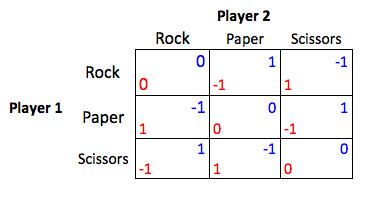 | ||
In game theory, a simultaneous game is a game where each player chooses his action without knowledge of the actions chosen by other players. Normal form representations are usually used for simultaneous games.
Rock-Paper-Scissors, a widely played hand game, is a real life example of a simultaneous game. Both make a decision at the same time, randomly, without prior knowledge of the opponent's decision. There are two players in this game and each of them has 3 different strategies to make decision; the combination of strategy profiles forms a 3×3 table. We will display Player 1’s strategies as rows and Player 2’s strategies as columns. In the table, the numbers in red represent the payoff to Player 1, the numbers in blue represent the payoff to Player 2. Hence, the pay off for a 2 player game in Rock-Paper-Scissors will look like this:
In game theory terms, Prisoner dilemma is an example of simultaneous game.
